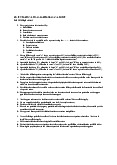








Preview text:
The Business School, RMIT VN —
BUSM2570: Business Decision Making (S1-2023)
Assessment 1: Case Study (Individual Assignment)
Assessment type: Case study, written report.
Due Date: Week 5, Monday, 03 April 2023 by 5:00pm (Vietnam time) Weighting: 20%
Word limit: 550 (+/- 10%). Exclude tables, figures, references. Submission:
The following assignment format requirements must be met: •
To be submitted through Canvas •
Save your completed paper with "Assignment_1_BUSM2570_ yourGroup_name.docx" as your filename. •
Text should be justified, 1.5 line spacing, character size 12 point, Times New Roman font,1-inch margins. Please
note that an Appendix contains information that is not essential to your report but supports your analysis and
discussion. If you put important information or discussion in an appendix, it will not be marked. •
References should be presented using the RMIT modified Harvard (author-date) referencing system. •
Quotations and sources of figures should be referenced. •
Clearly defined sections and sub-sections. •
You need to submit Word file and MS Excel files (if applicable).
Please note that RMIT treats plagiarism very strictly. All your work will be checked by
RMIT Online Detection Plagiarism System (ODPS). I recommend you write the report in
your own words and cite the information sources properly. Overview
In this assessment you will answer a series of questions your understanding of cost behaviour, Cost-Volume- Profit (CV )
P analysis as well as budget preparation and analysis concept you have learned in Weeks 1-4 to
answer the questions provided.
For this assignment, you will be creating a budgeting plan for yourself. This is an important skill to have as it
will help you manage your money effectively and reach your financial goals. It would help you greatly in your future businesses.
Remember, budgeting is a continuous process and requires ongoing attention. By learning how to create and
stick to a budget, you can take control of your finances and set yourself up for financial success. Good luck with your assignment! Assessment criteria
Each question in the assessment is awarded a number of marks, as indicated in the question.
Course learning outcomes
This assessment is relevant to the following course learning outcomes: CLO1
Describe and implement a structured approach to generating meaningful insights and informing
ethical decision making in business
Assessment instructions Step Description 1
Complete the simulation game provided in the appendix. 2
Read through the questions below.
Answer each of the questions using the information you have been provided with and 3
the results of your decisions made during the simulation.
Submit your answers in Canvas by the due date. All Word, Excel files must be
submitted along with your answers. Recommend 03 submitted files: 4
1. Your answers in MS Word format. We will mark on this file.
2. Appendix file with filled data
3. An MS Excel file to show your workings
HINT: When calculating your answers, you may find it is easier and quicker to use spreadsheet software
such as Excel or Google Sheets.
Remember to include all your workings in your submitted answers. Questions
Your task on this simulation was to begin management of your future financial plan, this is the first steps
for you to learn and implement any lessons into your future real businesses. After completing the
simulation game in the Appendix, answer the following questions regarding your results in this simulation:
1. Prepare a SWOT analysis about yourself. Provide examples from your studies, skills, and experience
to help explain your answers. Provide an overview of the types of decisions (strategic, tactical,
operational) you made to manage the ‘best’ future. Which of your decisions had unintended consequences? (4 marks)
2. a) Identify an example of a ‘fixed’ cost’ and a ‘variable’ cost from the simulation and explain why you
believe they are a variable cost or a fixed cost.
b) Explain why it is important for you to be able to recognise the difference between fixed costs and
variable costs. Use an example from the spreadsheet to help illustrate your answer. (3 + 1 = 4 marks)
3. Based on the data you have inputted in the simulation, with fixed pay rate: REQUIRED:
a) Calculate the breakeven point in working hours per week. Show your workings.
b) Calculate the margin of safety in monetary values. Show your workings. (2 + 1 = 3 marks)
4. You now plan the budget for next 4 months with your best estimated figures. You might consider any
new skills or experience that you can use in your work, it might result in a higher pay rate. Or any new
expenditure, such as new relationships, motor bikes, ect. Which might lead to an increase/decrease in
your budget balance. If so, clarify them. REQUIRED:
a) Analyse your budget throughout 5 months with trends and graphs or any techniques you have
learnt from the course. Show your workings and give us your comments on the analysis.
b) Write out your plan to be more successful and to make a better living. You will write a short essay
(200 words) explaining your path to future financial success (meaningful, structured paragraphs).
Please keep in mind that things do not always pan out the way you plan or want them to. (3 + 2 = 5 marks)
5. Provide correct and meaningful calculation, number in the appendix. (4 marks)
(Total marks = 20 marks) Submission format Written format.
Do you want to ask questions?
if you have questions, please go to this file and enter your questions there, we will check the file frequently
and answer them. Before you enter your questions, please read through them, and then maybe you can find the answers there.
Link: Questions_Answers_ASM1.xlsx
This way benefits all of us to know what questions that other students already asked, and you might find the
answers by just visiting the file. Extensions
If your assessment preparation has been impeded by unforeseen circumstances (such as illness, injury,
unexpected work commitments or carer responsibilities) you may be eligible for an extension.
Requests for extensions must be emailed to the course coordinator Dr. Chung Thanh Phan, Email:
Chung.phan@rmit.edu.vn, at least one working day before the assessment deadline using the extension
request form (available from the RMIT Extensions website).
If you are seeking an extension on or after an assessment due date, or you require an extension of more than 7
days, you must apply for special consideration. This is a confidential process.
Please see the RMIT extensions website for details regarding grounds for extensions and special consideration
and the required supporting documentation. Referencing guidelines
Use RMIT Harvard referencing style for this assessment.
You must acknowledge all the sources of information that you have used in your assessments.
Refer to the RMIT Easy Cite referencing tool to see examples and tips on how to reference in the appropriate
style. You can also refer to the library referencing page for more tools such as EndNote, referencing tutorials
and referencing guides for printing.
Academic integrity and plagiarism
Academic integrity is about honest presentation of your academic work. It means acknowledging the work of
others while developing your own insights, knowledge and ideas.
You should take extreme care that you have:
• Acknowledged words, data, diagrams, models, frameworks and/or ideas of others you have quoted
(i.e., directly copied), summarised, paraphrased, discussed or mentioned in your assessment through
the appropriate referencing methods
• Provided a reference list of the publication details so your reader can locate the source if necessary.
This includes material taken from internet sites
If you do not acknowledge the sources of your material, you may be accused of plagiarism because you have
passed off the work and ideas of another person without appropriate referencing, as if they were your own.
RMIT University treats plagiarism as a very serious offence constituting misconduct.
Plagiarism covers a variety of inappropriate behaviours, including:
• Failure to properly document a source
• Copyright material from the internet or databases
• Collusion between students
For further information on our policies and procedures, please refer to the University website. Assessment declaration
When you submit work electronically, you agree to the assessment declaration. Appendix
Name__________________________Date:______________________
Rules of the simulation (game)
You have finished your study at RMIT – You have to move to a city/province in Vietnam
You get no money or help from parents or friends. (Can’t live on family land or borrow from friends) Everyone must have a job.
Everyone has normal 40 working hours per week and might work some extra hours with higher pay rate.
You might not have to work 40 hours per week. No roommates - Y
- ou must not go into debt.
City & province where you will live: ______________ __________
Field your job will be in: ________________________________
What your pay rate should be: ________________________________
What your working hours should be: ________________________________
1. Calculate your weekly GROSS income. (working hours times your pay rate) VND _______________
2. Calculate your taxes per week. 10% (0.10 x GROSS pay): VND_________________________
3. Subtract your taxes from your weekly pay to get your NET pay. VND_________________________
In this project you must meet the 4 basic needs: Food, Clothing, Shelter, and transportation. SHELTER:
4. Find a place to rent (1 bedroom, 1 bath min) VND______________________
5. Figure up utilities: Water, Electric, Gas, Phone, Internet, TV – Are any included in the rent?
__________________________________________________________________________________
__________________________________________________________________________ FOOD:
6. How much a week will you spend on food? VND___________________ Per month VND____________
7. Where will you shop for food? ____________________________(just briefly name it)
8. Will you pack your lunch or eat out daily? __________________
9. How much will you spend each week on lunches? __________________ Per Month VND________ CLOTHING:
10. Set aside an amount you plan to spend on clothing each month. VND__________ Where _____________
11. Your apartment DOES NOT have a washer & dryer. How much will you spend on laundry each
month? (VND 30,000 per wash load – VND 30,000 per load to dry) VND________________ TRANSPORTATION:
Depending on where you live, you may need transportation to work. You can choose to drive o r use public transportation.
12. How will you get to work? _____________________
13. If using public transportation (bus, taxi, etc..), how much will you spend daily? VND_______________
a. Bus = VND 20,000 each way per day how much per month? VND_____________________
b. Taxi = VND 70,000 each way per day
14. If you have a car/motobike, you must figure up gas, insurance, & maintenance.
a. Gas VND___________ (gas costs VND 30,000 per litr e & you get 25 k m to the li r t e)
b. Insurance VND__________ (you are young, it will be high)
c. Maintenance VND__________ (keeping your car running safely) d. Total= VND______________
Add up all of your expenses for 1 month Name of Expense Monthly Bill 4. ________ ______ VND_________ 5. _______________ VND_________ 6. _______________ VND_________ 7. _______________ VND_________ 8. _______________ VND_________ 9. _______________ VND_________ 10. ______________ VND_________ 11. ______________ VND_________ 12. ______________ VND_________ 13. ______________ VND_________ 14. ______________ VND_________ Total VND_________
Multiply your weekly NET pay by 4 Net Pay (line 3) X 4_________ VND Monthly NET Pay Monthly Expenses
Which one is more? ________________ (Pay or Bills)
Are you in debt? ___________________ How much in debt or left over? _____________________
If you are in debt, YOU MUST CHANGE YOUR BUDGET!! MAKE A LIST OF THE EXPENSES YOU WILL CHANGE
AND HOW MUCH EACH CHANGE WILL SAVE YOU.
_________________________________________________________________________________________
_________________________________________________________________________________________
_________________________________________________________________________________________
What are your new monthly expenses? VND _______________________________________
How much money do you have left each month? VND_______________________________
Is this enough money to spend on a date? ________ Are you a guy? _____
Do you plan to have a girlfriend? _________
Be sure to include money that you would spend on dates, nightlife, etc., VND__________________
What will you do with the money you have left over? (Make Specific plans)
How can you improve your chances of making more money?
________________________________________




